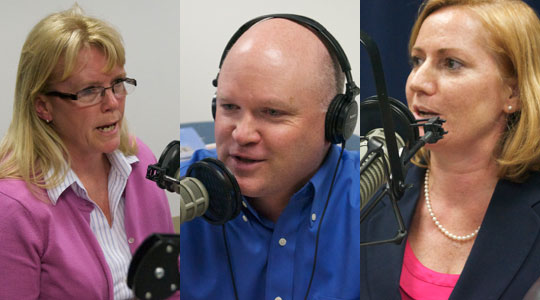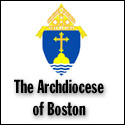Summary of today’s show: One of the biggest initiatives in the Archdiocese of Boston is one of the least well-known. The Improved Financial Relationship Model (IFRM) changes the way parishes support the Central Ministries and gives the Central Ministries a more immediate stake in the financial health of parishes. Scot Landry talks with Denise McKinnon-Biernat and Patricia Fraser from Parish Financial Services about the IFRM and how the first parishes to participate are already seeing good fruit from their efforts.
Listen to the show:
Podcast: Play in new window | Download
Today’s host(s): Scot Landry
Today’s guest(s): Patricia Fraser, IFRM Project Manager, and Denise McKinnon-Biernat, Director of Parish Financial Services
Links from today’s show:
Today’s topics: Improved Financial Relationship and Parish Financial Services
1st segment: Scot said one of the largest initiatives going on in the Archdiocese of Boston that listeners may not have heard about. The Improved Financial Relationship Model (IFRM) is aimed to strengthen parishes.
Scot welcomed Denise McKinnon-Biernat to the show. She’s been working at the Archdiocese since 1996. She lives in Bellingham and worships at St. Mary in Franklin. That’s also Patricia Fraser’s parish. she’s worked with Archdiocese since 2008. Scot said St. Mary’s is one of the largest in the Archdiocese. They recounted some of the other very large parishes in the Archdiocese. It’s often a parish in a growing suburb with no other parishes.
Scot asked Denise about Parish Financial Services. She said it was created to be a liaison between the central ministries and the parishes. They help parishes with budgets, increased giving, staffing, payroll, and any other administrative operations in a parish. They typically work with business managers, if they have one, or with the pastors. She said they’ve been working hard to create a ministerial aspect to the job of the business managers. They’ve also been working to standardize many of the functions of the parish finances, like standardizing financial software across parishes.
Scot said many pastors have come to realize that they need business managers and that pastors have much more to do than manage business functions. But many of these business managers need some help dealing with issues that come up. Parish financial services often networks the business managers with each other and helps with problem solving. Tricia said pastors are so stretched in their pastoral ministry they help business managers take on the other tasks required. They organize regional meetings of business managers to share the knowledge they have gained.
Scot said some business managers have worked in the Church, while others have worked successfully in corporate environments and want to serve the Church in their later years. Denise said about 60% of current managers have come up through the parish, having worked with the parish in other ways. About 40% and more now, come in as a second career. They help them apply their business acumen to the unique needs of parishes.
Scot talked about the Revolving Loan Fund, which is like a church bank, where parishes deposit their reserves and parishes who have cash flow needs can get temporary help. Tricia said they recommend parishes keep 3 months of operating funds and put the rest in the loan fund where it earns interest. There are lots of reasons a parish would need a loan.
Denise said they help parishes to increase their weekly giving, work with their grand annual, work with their cash flow or envelope companies or budget. They help them with their annual reporting to parishioners and may even provide a loan, particularly in the summer when everyone’s on vacation. There are also grant opportunities for parishes that are really in trouble. Scot said parishes at the other extreme, that are growing very fast, they can help them have a capital campaign and hire fundraising counsel. As parish financial services, they help parishes with funding of parish work, help them decide if they need a campaign and then help them do a survey of the potential. They also provide a bridge loan over the three to five years it takes to bring in the money from a campaign.
2nd segment: Scot said they will not talk about the Improved Financial Relationship Model. He said they first formed a committee in 2008 to address the particular problem. Denise said the Cardinal had formed the IFRC (i.e. committee) to look at the current model of support of parishes and the archdiocese. The current model was complex with all kinds of taxes and fees and pastors felt they were being nickeled and dimed and the timing was all over the place. The idea was to build a model that was simple and good for both parishes and the archdiocese.
Scot said models of support evolved over time previously. The main way that parishioners helped support the Central Ministries was the Catholic Appeal, then the cathedraticum, health care ministries tax, school tax from schools without schools to schools with, audit fees, real estate and facilities fees. Scot said the issue was how to get parishes to support the ministries that help them in a way that’s simple and fair.
Denise said they surveyed other dioceses and most had a simple, broad-based across the board percentage. They used that as part of their new model. They have two basic components with a set monthly bill that parishes can budget for.
Scot said another problem was the inequality of the sharing across parishes. Some parishes were giving as little as 2% and as much as 36%. A little difference is understandable but that’s too much. It’s not just the poor parishes giving little and rich giving a lot. Tricia said this was one of the key sticking points with pastors. Also there was no accountability for parishes that didn’t work hard at the Catholic Appeal. This came from pastors, not the pastoral center.
Scot said the committee then embarked on a long consultation process. Tricia said the IFRC committee did a great job. Many came from the parishes to give their input and as a result the model we have now is different from the proposal. They also recommended to have a voluntary pilot phase. They were afraid parishes would not embrace change, but 33 parishes came forward.
Scot recalled that there had been 30 different revenue categories that parishes had including candle funds, heating fuel, Easter flowers, and the like. they needed to determine what budget items went toward their operating costs. They eventually came up with three main categories of revenue to calculate the fair share: the weekly offertory, the Grand Annual collection, and net rental income.
Tricia said Grand Annual can fund special projects, but more and more it was going toward basic operating costs. Some pastors are unhappy with it being taxed because it wasn’t taxed before. Scot said some parishes had valuable locations for their parking lots or extra buildings that they rented out and made substantial income. Denise aid rental income has really taken off in the past five years and more and more parishes are becoming dependent on rental income. In fairness to parishes paying the same expenses without having rental income, they had to include it.
Tricia said they do a three-year loopback average to even out spikes. They take that average and it becomes the base revenue. Once all are agreed, they multiply it by 10%. If they don’t have a school, that’s the central ministry tithe and they divide it by 12 and pay it out over 12 months. Then they use the same base revenue number and 8% becomes the Catholic Appeal assessment. The parish used to have a goal, which is usually higher, but the 8% is what the parish is accountable for bringing in. Scot said a lot of parishes from the initial phases have had Catholic Appeal far greater than the 8%. Tricia said once a parish’s pledges reaches 8%, the parish earns 50% back to the parish, which is significantly more than there used to be in the old model.
Denise said in the new model was revenue neutral from the Central Ministry viewpoint. The Archdiocese isn’t taking more money out of the parishes. Now as the Archdiocese helps parishes increase revenue, the central ministry revenue goes up. And if it goes down, it’s a motivation to help the parishes. Scot said it’s not a zero-sum game, but if the parishes get more, the Archdiocese gets more.
3rd segment: Scot asked how many parishes followed for phase II? Tricia said when they went back to the presbyteral council on the first round of pilot parishes, they were sent to go back for phase II and 45 parishes signed up for that. Thus far, they have had 61 parishes volunteer for phase III and more are coming in every day. Scot said Cardinal Seán very much wanted parishes to opt-in and nearly half of the parishes have done so.
Scot said many in phase II have heard and seen the results. Tricia said another critical element of the IFRM was having parishes run an increased giving campaign. And Parish Financial Services also focuses on the improved relationship model as well.
The phase I parishes ran their increased giving campaigns one year ago and those 33 parishes increased by
$1.3 million, or 11% overall. Parishes not involved in IFRM over the same time period had about 1% increase. (That includes parishes that ran increased offertory on their own.)
Denise said they structured programs that were tailored to the parishes. They brought in fundraising consultants who got to know the parishes and went through programs fit to the parishes. Scot said many parishes hadn’t run increased offertory campaigns in five to ten years. Most experts say parishes should remind parishes every three years that expenses are rising and old parishioners might give a little more and new parishioners might show up. Many respond to the pastor laying out the facts of what the parish needs.
Tricia said Phase II are running this year and early results are in that indicate that increased offertory campaigns are just as strong as phase I. These campaigns are working in suburbs and cities as well.
Scot asked Tricia how the greater sharing in the Catholic Appeal is helping parishes with more money. Tricia said the 50% rebate in the first year is double what they used to get. But phase I and II parishes now realize that this is a joint fundraising effort that benefits both the parish and the archdiocese. She said at the close of the Appeal last year there was about $1 million of rebates to parishes, $850,000 went to IFRM parishes, which made up a small percentage of the total number of parishes. Scot said most of the IFRM parishes are doing much better than under the old model.
Tricia warned that it is not a cure-all, but gives them the best tools to increase viability, to pay off debt.
Scot said one of the best non-monetary benefits is the close working relationship between parishes and the central ministries. A pastor got up at a meeting to say that the parish had completely changed its attitude toward the Archdiocese.
Scot asked Tricia how they help a new business manager. She said they begin by getting the word out, meeting in the parish with parish councils, finance council, to help them understand what the IFRM means for their parish. They walk through their numbers and show them where they’re at and the impact on the budget. They start work with the development consultants for increased offertory. The parish can also apply for an abatement to get some relief from paying for part of that tithe this year. Scot said it helps parishes that believe in the model to make the difficult transition.
Denise said 11 total parishes have gone through the abatement process. Part of the process make their office part of the solution so they can identify the issues when making the budget, for instance. Abatement is about being with the parishes on the journey and helping them get to where they want to be.
One pastor said the IFRM saved his life because he’s no longer stressed about the parish’s finances.








Comments Closed